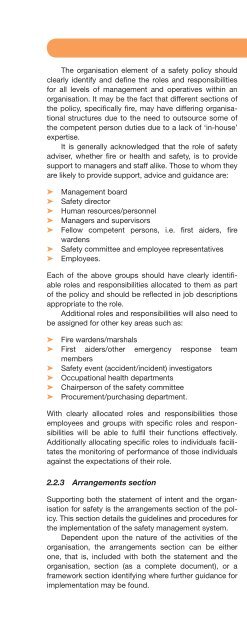Introduction to Fire Safety Management
Introduction to Fire Safety Management
Introduction to Fire Safety Management
You also want an ePaper? Increase the reach of your titles
YUMPU automatically turns print PDFs into web optimized ePapers that Google loves.
The organisation element of a safety policy should<br />
clearly identify and defi ne the roles and responsibilities<br />
for all levels of management and operatives within an<br />
organisation. It may be the fact that different sections of<br />
the policy, specifi cally fi re, may have differing organisational<br />
structures due <strong>to</strong> the need <strong>to</strong> outsource some of<br />
the competent person duties due <strong>to</strong> a lack of ‘in-house’<br />
expertise.<br />
It is generally acknowledged that the role of safety<br />
adviser, whether fi re or health and safety, is <strong>to</strong> provide<br />
support <strong>to</strong> managers and staff alike. Those <strong>to</strong> whom they<br />
are likely <strong>to</strong> provide support, advice and guidance are:<br />
➤ <strong>Management</strong> board<br />
➤ <strong>Safety</strong> direc<strong>to</strong>r<br />
➤ Human resources/personnel<br />
➤ Managers and supervisors<br />
➤ Fellow competent persons, i.e. fi rst aiders, fi re<br />
wardens<br />
➤ <strong>Safety</strong> committee and employee representatives<br />
➤ Employees.<br />
Each of the above groups should have clearly identifi -<br />
able roles and responsibilities allocated <strong>to</strong> them as part<br />
of the policy and should be refl ected in job descriptions<br />
appropriate <strong>to</strong> the role.<br />
Additional roles and responsibilities will also need <strong>to</strong><br />
be assigned for other key areas such as:<br />
➤ <strong>Fire</strong> wardens/marshals<br />
➤ First aiders/other emergency response team<br />
members<br />
➤ <strong>Safety</strong> event (accident/incident) investiga<strong>to</strong>rs<br />
➤ Occupational health departments<br />
➤ Chairperson of the safety committee<br />
➤ Procurement/purchasing department.<br />
With clearly allocated roles and responsibilities those<br />
employees and groups with specifi c roles and responsibilities<br />
will be able <strong>to</strong> fulfi l their functions effectively.<br />
Additionally allocating specifi c roles <strong>to</strong> individuals facilitates<br />
the moni<strong>to</strong>ring of performance of those individuals<br />
against the expectations of their role.<br />
2.2.3 Arrangements section<br />
Supporting both the statement of intent and the organisation<br />
for safety is the arrangements section of the policy.<br />
This section details the guidelines and procedures for<br />
the implementation of the safety management system.<br />
Dependent upon the nature of the activities of the<br />
organisation, the arrangements section can be either<br />
one, that is, included with both the statement and the<br />
organisation, section (as a complete document), or a<br />
framework section identifying where further guidance for<br />
implementation may be found.<br />
<strong>Safety</strong> policy<br />
Regardless of the mechanism that is used, i.e.<br />
integrated or framework, many core elements remain the<br />
same. The following bullet pointed list is indicative of the<br />
areas included in an arrangements section:<br />
➤ Access and egress ➤ Housekeeping<br />
➤ Accidents/incidents ➤ Lone working<br />
➤ Alcohol/drugs ➤ Manual handling<br />
➤ Asbes<strong>to</strong>s ➤ Noise at work<br />
➤ Consultation with ➤ Personal protective<br />
employees equipment<br />
➤ Control of contrac<strong>to</strong>rs ➤ Permit <strong>to</strong> work<br />
➤ Display screen health ➤ Plant and machinery<br />
and safety ➤ Offi ce equipment<br />
➤ Electrical safety ➤ Ladders and other access<br />
➤ Employment of devices<br />
young persons ➤ Risk assessment<br />
➤ Environmental safety ➤ Security and staff safety<br />
➤ Hazardous substances ➤ Signage<br />
(COSHH) ➤ Smoking<br />
➤ Health surveillance ➤ Stress<br />
➤ <strong>Fire</strong> and emergency ➤ Temporary and casual staff<br />
arrangements ➤ Training/information<br />
➤ First aid ➤ Utilities and services<br />
➤ Food hygiene ➤ Visi<strong>to</strong>rs<br />
➤ <strong>Safety</strong> inspections ➤ Waste disposal<br />
and safety <strong>to</strong>urs ➤ Working at height<br />
➤ Hours of work ➤ Working environment<br />
Some or all of the above arrangements in larger or<br />
more complex organisations may have their own individual<br />
policy, organisation and arrangements sections.<br />
Regardless of whether each element of the arrangements<br />
section is included within the overall health and<br />
safety policy or whether it is an independent policy<br />
and/or set of procedures, a critical issue is that those<br />
persons nominated in the organisation section of the<br />
policy are aware of the arrangements for which they<br />
have responsibility.<br />
<strong>Fire</strong> safety policy<br />
The fi re safety policy of an organisation should be structured<br />
along the same lines as the general health and<br />
safety policy, i.e. it should have a statement of commitment,<br />
roles and responsibilities of persons charged with<br />
implementing the policy and detail arrangements.<br />
The arrangements detailed below will invariably be<br />
included in any fi re arrangements section; however, in<br />
order <strong>to</strong> fully appreciate whether all areas are covered the<br />
completion of a fi re safety review or fi re risk assessment<br />
will help <strong>to</strong> identify any shortcomings in the arrangements<br />
33

















